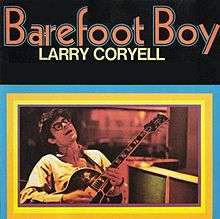Barefoot Boy
| Barefoot Boy | ||||
|---|---|---|---|---|
 | ||||
| Studio album by Larry Coryell | ||||
| Released | 1971 | |||
| Recorded | at Electric Lady Studios, New York City | |||
| Genre | Jazz, Jazz fusion | |||
| Length | 40:35 | |||
| Label | Flying Dutchman / Atco | |||
| Producer | Bob Thiele | |||
| Larry Coryell chronology | ||||
| ||||
| Professional ratings | |
|---|---|
| Review scores | |
| Source | Rating |
| Allmusic | |
| Christgau's Record Guide | B+[2] |
| The Rolling Stone Jazz Record Guide | |
Barefoot Boy is Larry Coryell's first and only album for the Flying Dutchman label, a company created by Impulse! Records founder Bob Thiele. The album was produced by Thiele, with production assistance from Lillian Seyfert and engineered by Eddie Kramer. Barefoot Boy was recorded at Electric Ladyland in New York City, according to the album's liner note with a certain level of spontaneity.
Original liner notes by Bob Palmer
| “ | Spontaneity is the spark that fires the music of Larry Coryell, and this is especially true of the Coryell represented on this album. Larry was an original on his very first recordings with Chico Hamilton and with The Free Spirits, produced by Bob Thiele, and he has continued to grow through the succeeding years. He is now a guitar player's guitar player, but... his outstanding quality is still the warmth and joy he communicates through moment-to-moment creation.
A sharp, icy wind was blowing the nights of these sessions, and Coryell and his musicians arrived at Electric Lady studios ready to burn. Ace engineer Eddie Kramer was ready behind the dials, so that there were few wasted moments, and no false starts. The musicians got right down to business, and Kramer made sure their first efforts were captured with balance and fidelity, so that second takes were unnecessary. It should come as no surprise that the studio which is now a monument to one of the great ELECTRIC guitarists of the age, Jimi Hendrix, inspired Coryell to make his most ELECTRIC recording to date. Gabor Szabo's "Gypsy Queen", also recorded by Santana, is an especially strong example of how Larry combines the fleet-fingered imagination of a jazzman with the use of feedback and textural effects pioneered by rock guitarists like Hendrix. "Gypsy Queen" was the result of the presence of some players and the absence of others early on the second night of recording. The rhythm section of drum veteran Roy Haynes, percussionist Harry Wilkinson (who handles the drum set in Coryell's performing group), and conga player Lawrence Killian locked together immediately into an engine of unbelievable power, and Coryell and saxophonist Steve Marcus, left to shoulder the entire melodic and harmonic weight, responded to the challenge with playing that had the listeners in the control booth first sitting on the edge of their seats, them smiling broadly, and finally jumping up and down. It was one of those examples of turning an unlooked-for situation to great advantage that makes the creativity of improvised music even more exciting than it ordinarily is. The addition of Mervin Bronson, a rock-solid Soul Man, on bass, and, at the second session, pianist Michael Mandel, rounded out a fine group and made a more lyrical approach possible. Yet the music, even at its prettiest, retained the fire and inspiration of "Gypsy Queen". The atmosphere at Electric Lady contributed to a balance of free expression and technical precision that gave the music room to grow and become, so that the resulting album displays both the singular chops and the singular warmth of Larry Coryell, complemented by a variegated and committed group of fine musicians. |
” |
Track listing
All songs except "Gypsy Queen" were composed by Larry Coryell.
- Side one
- "Gypsy Queen" – 11:50 (Gábor Szabó)
- "The Great Escape" – 8:39
- Side two
- "Call To The Higher Consciousness" – 20:00
Personnel
Musicians
- Larry Coryell - guitar
- Steve Marcus - soprano saxophone, tenor saxophone
- Lawrence Killian - conga
- Roy Haynes - drums
- Harry Wilkinson - percussion
- Mervin Bronson - bass
- Mike Mandel - piano
Production
- Bob Thiele - producer
- Lillian Seyfert - assistant producer
- Bob Gruen - cover & liner photographs
- Eddie Kramer - sound mixer
- Ultura Concepts - design
- Bob Palmer - liner notes
Single
- "The Great Escape" (3:00) / "Gypsy Queen" (2:58) - Flying Dutchman/Atco FD-26012; released 1971 (U.S.)
References
- ↑ Newsom, Jim. "Barefoot Boy - Larry Coryell | AllMusic". allmusic.com. Retrieved 13 August 2011.
- ↑ Christgau, Robert (1981). "Larry Coryell". Christgau's Record Guide: Rock Albums of the '70s. Da Capo Press. ISBN 0306804093. Retrieved July 6, 2014.
- ↑ Swenson, J. (Editor) (1985). The Rolling Stone Jazz Record Guide. USA: Random House/Rolling Stone. p. 51. ISBN 0-394-72643-X.